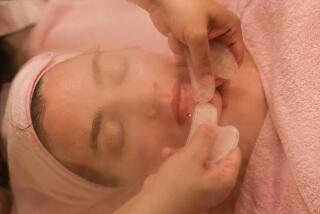Move Over, Retin-A; Chemical Peel Seen as Latest Fountain of Youth
When Barbara Snegg of Huntington Harbour was a teen-ager, she spent her summer days smearing her skin with the trendiest concoction of the ‘50s: baby oil and iodine.
The combination was supposed to maximize the sun’s effect, and it did. Snegg, now 53, not only got a summer-long suntan, but something more lasting and less attractive: wrinkles.
That’s why, as this summer began, Snegg’s doctor carefully painted her face with the hottest facial treatment of the ‘90s: trichloroacetic acid, a chemical that’s literally so hot it burns.
The acid burned off the outer layer of skin on Snegg’s face, which then peeled over a two-week period to reveal a new growth of pinker, smoother and younger-looking skin.
The procedure is called a chemical peel, and it’s the fastest-growing non-surgical procedure being done to make aging faces look younger, according to Dr. Michael Niccole, medical director of CosmetiCare Plastic Surgery Specialists in Costa Mesa.
Niccole, who performed the peel on Snegg, says there were 13,732 chemical peels performed in 1990 by members of the American Society of Plastic and Reconstructive Surgeons, up 46% from 1988.
Dr. Stephen Sutherland, who works with Niccole, says one reason for the increase is the switch from phenol, the chemical originally used in chemical peels, to trichloroacetic acid, or TCA, for many patients.
With TCA, patients can recover in about two weeks, instead of the two months required for a phenol peel. Although both chemicals bleach the skin, the effect is less noticeable with TCA, Sutherland says.
Phenol is still used for patients who have deeper wrinkles, he says, because it causes a deeper burn.
The procedure can be done in a doctor’s office, with the patient either under sedation or general anesthesia. It takes about half an hour, Sutherland says, and then the patient is sent home with a supply of pills for the pain, which is usually gone in a day or two.
It costs about $1,500 to $2,500, compared to the $5,000 to $7,500 cost of a surgical face lift.
As with other cosmetic procedures, chemical peels are usually not covered by health insurance plans.
Non-monetary costs, such as the amount of pain involved and the risk of scarring, are also reduced with non-surgical procedures, although they are still part of the process, the doctors say. With chemical peels, patients must endure the pain of the burn itself, and accept the possibility of scarring.
“We would recommend a chemical peel for someone who’s younger and not really ready for a face lift, someone who just wants to change their facial skin texture,” Sutherland. “It can also be done in conjunction with a face lift, separated by several months.”
Most chemical-peel patients are in their 40s or older, although Sutherland says he has had some in their 30s.
The skin-smoothing effect lasts about five years. After that, the patient can choose to have the procedure repeated or allow the skin to age naturally. Surgical face lifts, by contrast, last about 10 to 15 years, Sutherland says.
Those who want to erase some of the effects of time and sun but without the discomfort and expense of a chemical peel or surgery may want to check into Retin-A, the super-concentrated form of Vitamin A approved several years ago for use as a wrinkle remover. But after the initial burst of interest, use of Retin-A is now declining, Sutherland says.
“People are finding that it causes more of a sun sensitivity, as well as flaking and red skin, and they’re not quite as happy with it as they expected to be. It does work, but it has to be used on a daily basis,” he says.
Snegg’s husband, David, 68, uses Retin-A every day on the advice of his dermatologist.
“It works, if you follow the directions and don’t do anything foolish,” she says.
Retin-A costs about $75 to $85 a month, Sutherland says, and it must be used in conjunction with a sun-blocking agent.
“It’s good for someone who just wants to get rid of very small wrinkles, the very tiny things that form at the corners of the eyes, to improve the overall quality of the skin,” he says.
Like a chemical peel, Retin-A usually causes about two weeks of initial peeling.
Where and when wrinkles start varies from person to person, Sutherland says, but one common area is the nasal-labial fold, or smile line. To erase or minimize those, plastic surgeons can inject either collagen, made from cows, or the patient’s own fat that has been removed by suction from another part of the body.
“A collagen injection can make those lines temporarily disappear for three to six months,” Sutherland says. It costs about $300.
A couple of years ago, fat injections were nearly as popular as collagen, but Sutherland says that’s changing now because “fat has had kind of a spotty history. The major problem is the fragility of the fat cells. When you do a skin graft, the cells usually do quite well growing in another part of the body. But fat cells don’t seem to travel as well.”
Fat injections cost about the same as collagen. Although they were initially often done in conjunction with liposuction, a procedure in which fat tissue is literally vacuumed out of certain areas of the body, now doctors are getting better results by transplanting small amounts of fat using a hand syringe, Sutherland says.
Although any licensed medical doctor can perform any of these procedures, Niccole and Sutherland say patients should check out their doctor beforehand.
“Make sure you’re dealing with a reputable plastic surgeon,” Sutherland says. They recommend that the doctor be board certified, with considerable experience performing the procedure in question. Patients should get more than one opinion and ask prospective doctors for patient references before deciding to undergo the treatment.
“This isn’t for everybody,” Sutherland says. “It’s a matter of the individual’s level of comfort. If they’re feeling uncomfortable with the way they look, there’s no reason for them to continue to be uncomfortable. They can be helped.”
Snegg says she looked into various possibilities before deciding on a chemical peel.
“I got old enough where I saw a few extra lines here and there, and we were in a position financially where I could do something about it, so my husband said, ‘Go for it!’ ” she says. “Being a native Californian, I spent a lot of time roasting myself on the beach as a teen-ager, and I had the lines to prove it.”
She was under general anesthesia for the procedure, and when she woke up, “it was a little warm, a little like getting a burn. But it wasn’t so terribly bad that I couldn’t stand it. I used ice, and after the first few hours, I was fine.
“The night after the procedure, a friend came over, and we chatted and did some work for the (Huntington Harbour) Cancer League, and watched TV.”
A week later, she went out, wearing sunglasses and heavy makeup, to an important dinner for her husband, and by the 10th day the burnt skin had peeled off. Snegg’s skin stayed red for a couple of months.
Those summers in the sun also have left Snegg acutely aware of the sun’s other dangers, including skin cancer. “My husband has had some skin cancers removed already,” she says. “I’m just fortunate that all I got were wrinkles. And I was lucky that I could do something about them.”
More to Read
Sign up for Essential California
The most important California stories and recommendations in your inbox every morning.
You may occasionally receive promotional content from the Los Angeles Times.










